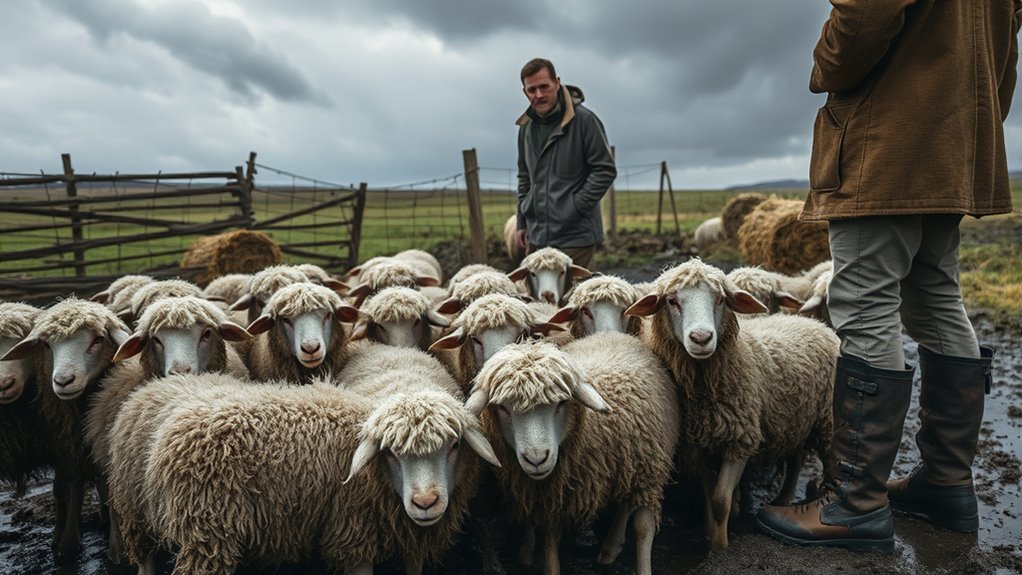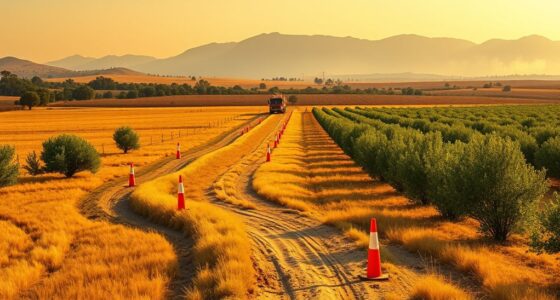Raising sheep has its drawbacks. You'll face market fluctuations that can affect profitability, along with the risk of predation and the ongoing battle against diseases. Extensive fencing is necessary to keep your flock safe, while daily management tasks can be time-consuming. You also need to consider complications during lambing and the importance of mineral supplementation. If you want to explore these challenges in more detail, there's plenty more to learn about sheep farming.
Key Takeaways
- Market fluctuations can lead to unpredictable pricing, making it difficult to ensure consistent profitability in sheep farming.
- Sheep are highly vulnerable to predators, requiring significant investments in fencing and deterrent measures to protect the flock.
- Health issues and diseases, like internal parasites, can severely impact sheep health and require ongoing management and treatment efforts.
- Extensive fencing is necessary for effective sheep management, which can be costly and time-consuming to install and maintain.
- Daily management tasks are labor-intensive, with peak seasons demanding constant oversight and adding to the overall workload and expenses.
Market Fluctuations and Profitability Challenges

When you decide to raise sheep, you'll quickly realize that market fluctuations can significantly impact your profitability. Lamb prices can swing wildly due to supply and demand imbalances, making it essential to stay informed.
Global events and changing consumer preferences can lead to sudden shifts, leaving your financial stability in jeopardy. Prices often peak in late spring and early summer, requiring you to plan strategically.
Additionally, starting a sheep farm demands a substantial initial investment, especially for purebred stock. Small flocks face heightened challenges, as high labor costs per animal can diminish returns.
While the potential for quicker ROI exists, it's highly contingent on your management skills and market conditions. Staying adaptable will be crucial as you navigate these challenges.
Vulnerability to Predators
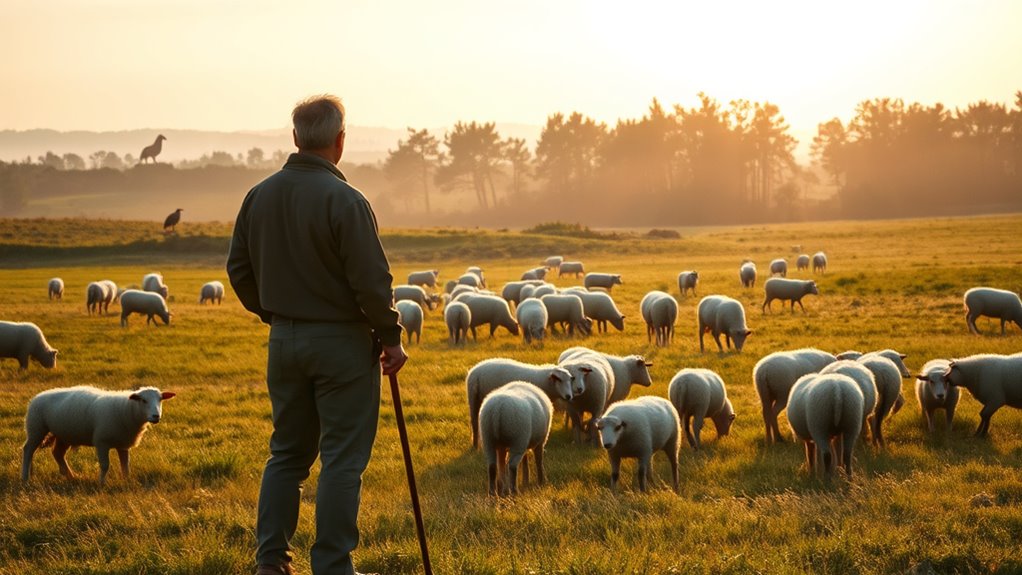
Raising sheep can be particularly challenging due to their vulnerability to a variety of predators. Coyotes, domestic dogs, and cougars are among the most common threats you'll face.
Each region poses different challenges; for instance, coyotes are a significant concern in North America, while cougars threaten sheep in South America. Unfortunately, predation can lead to serious financial losses for you as a producer.
Sheep's natural flight response can actually trigger predators, putting them at further risk. To manage these threats, many farmers use fencing, guard dogs, and other deterrents.
Sheep's instinctive flight response can increase their vulnerability, making effective predator management essential for safeguarding your flock.
It's crucial to stay vigilant and implement effective predator control methods to protect your flock from these dangers.
Health Issues and Disease Management

While sheep farming can be rewarding, managing health issues and diseases poses significant challenges. Internal parasites like nematodes and lungworms can lead to weight loss and anemia, and the overuse of anthelmintics has caused resistance, complicating treatment.
Watch for symptoms like diarrhea and poor growth. Diseases such as Caseous Lymphadenitis and Johne's Disease can further impact your flock's health and productivity.
Implementing vaccination programs, monitoring fecal egg counts, and practicing pasture management are essential strategies for disease control. Regular health checks and proper nutrition can bolster your sheep's immune systems.
Extensive Fencing Requirements
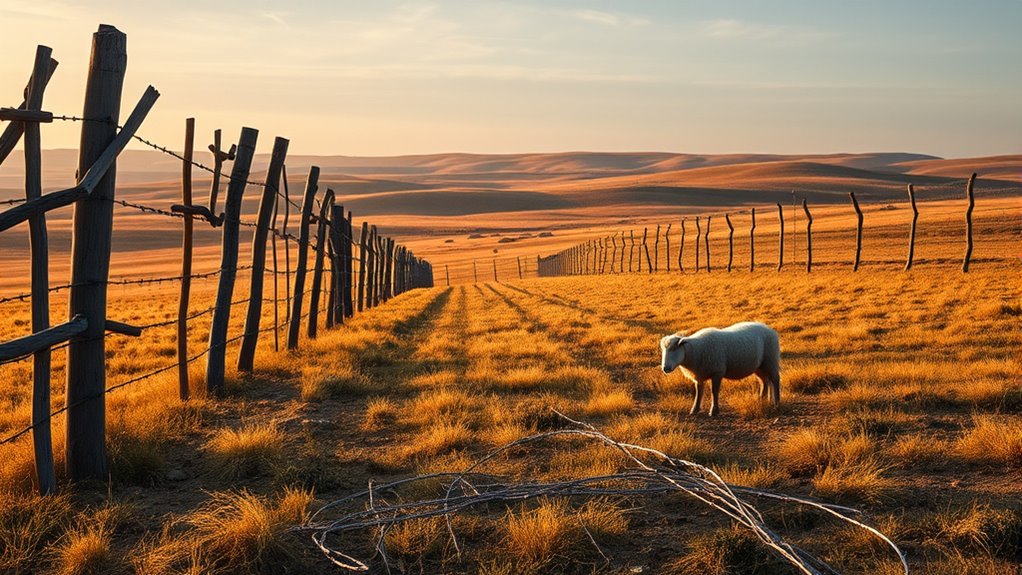
Establishing a successful sheep farm hinges on extensive fencing requirements, as proper barriers are crucial for protecting your flock from predators and preventing escapes.
You'll need robust fencing to guard against dangers like coyotes and bears, which means considering options like electric or woven wire fences instead of traditional barbed wire. Aim for a minimum height of four feet, though taller fences provide better protection.
High-tensile wire is a durable choice, while proper post spacing of 8 to 12 feet ensures optimal security. Regular maintenance is essential to keep your fencing effective, and adding electrified wires can enhance deterrence.
Though costly, investing in appropriate fencing ultimately safeguards your sheep and protects your livelihood.
Time-Consuming Daily Management
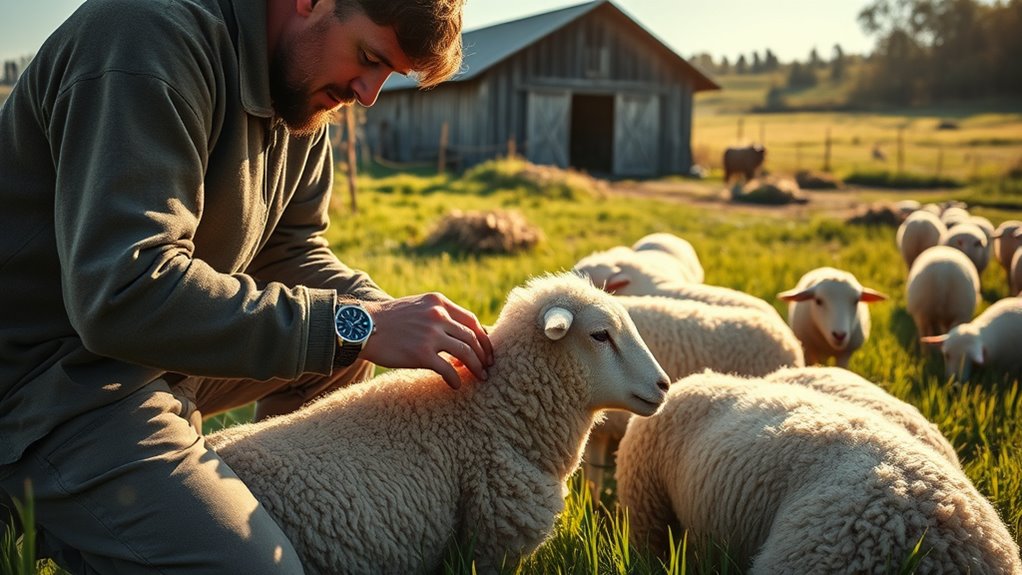
Managing a sheep farm requires a significant daily time investment, especially when it comes to essential chores like feeding, watering, and monitoring the health of your flock.
Daily tasks can become particularly demanding during peak seasons, such as lambing, where constant oversight is crucial to prevent mortality. You'll also need to conduct regular checks for predator protection and manage hoof care, which adds to your workload.
Grazing management, including rotating pastures and monitoring their quality, is another time-intensive task. On top of these responsibilities, you'll find yourself maintaining health records, preparing sheep for market, and prioritizing tasks to keep everything running smoothly.
Hidden Illness and Late Detection
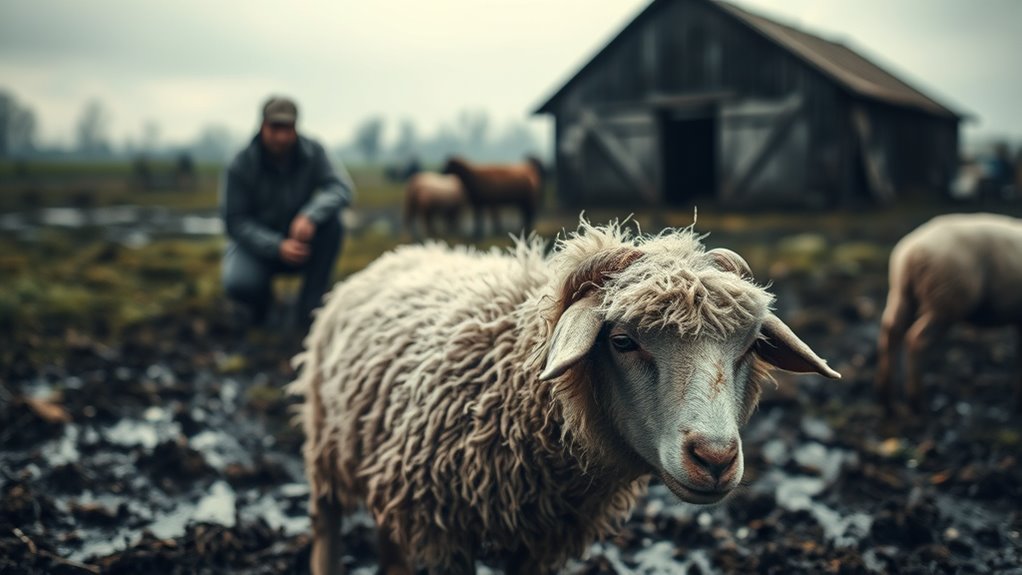
Recognizing and addressing hidden illnesses in your flock can be just as challenging as daily management. Diseases like Maedi Visna (MV) can linger undetected for one to three years, with up to 30-40% of your sheep potentially infected without showing symptoms.
This silent spread through nose-to-nose contact complicates early detection, often resulting in severe organ damage before signs appear. Regular serological testing is essential, but it requires commitment and resources.
The economic impact is significant; infected ewes may struggle with fertility and milk production, leading to financial losses. Implementing strict biosecurity measures and collaborating with veterinarians can help mitigate these risks, but the hidden nature of these illnesses makes constant vigilance a necessity in sheep management.
Common Foot Problems in Sheep

While raising sheep can be rewarding, common foot problems can pose significant challenges to your flock's health and productivity.
Footrot, caused by *Dichelobacter nodosus*, is particularly painful and thrives in wet conditions. Similarly, foot scald, linked to *Fusobacterium necrophorum*, often leads to more serious infections.
Contagious Ovine Digital Dermatitis (CODD) and foot abscesses are also concerns, especially in muddy pastures. Prolonged moisture and warm temperatures create ideal environments for these bacteria.
The economic impact can be substantial, with reduced grazing efficiency, increased treatment costs, and lower market value.
Implementing preventive measures like footbathing, regular trimming, and biosecurity practices can help manage these issues and keep your sheep healthy.
Complications During Lambing
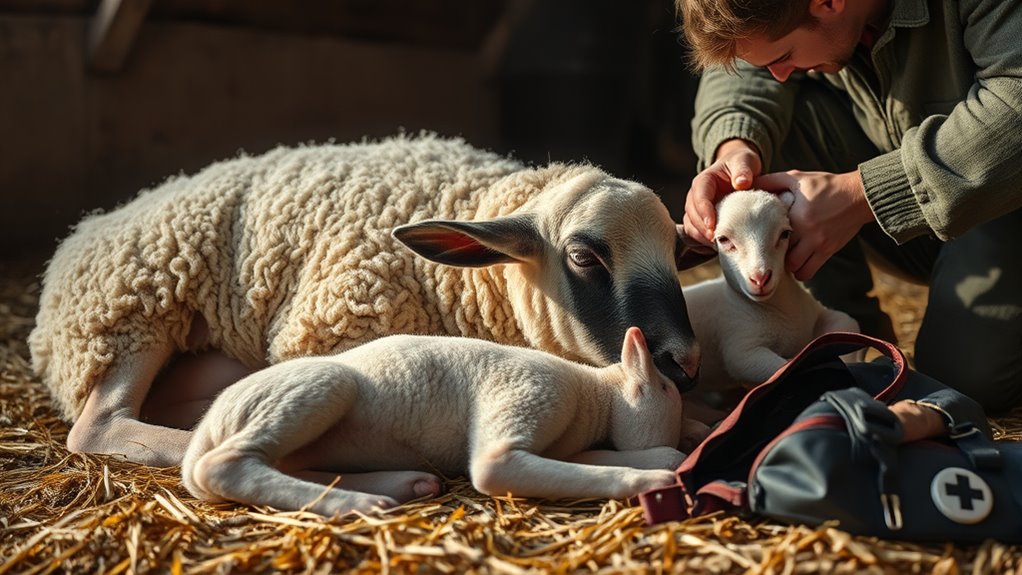
Complications during lambing can arise unexpectedly and pose serious risks to both ewes and their newborns. Malpresentations, like breech births, can complicate delivery and might require your intervention.
You may encounter ringwomb, where the cervix doesn't dilate properly, often needing manual help or a caesarean section. Be cautious, as excessive traction during delivery can lead to trauma, especially in certain breeds, causing fractures or internal injuries.
Unhygienic conditions can also result in infections like navel ill or watery mouth in lambs.
Unhygienic conditions during lambing can lead to serious infections like navel ill or watery mouth in newborns.
Post-lambing, uterine prolapses may occur, necessitating immediate veterinary attention. Being prepared and vigilant can help you address these issues effectively, ensuring the health of both ewes and their lambs during this critical time.
Importance of Mineral Supplementation
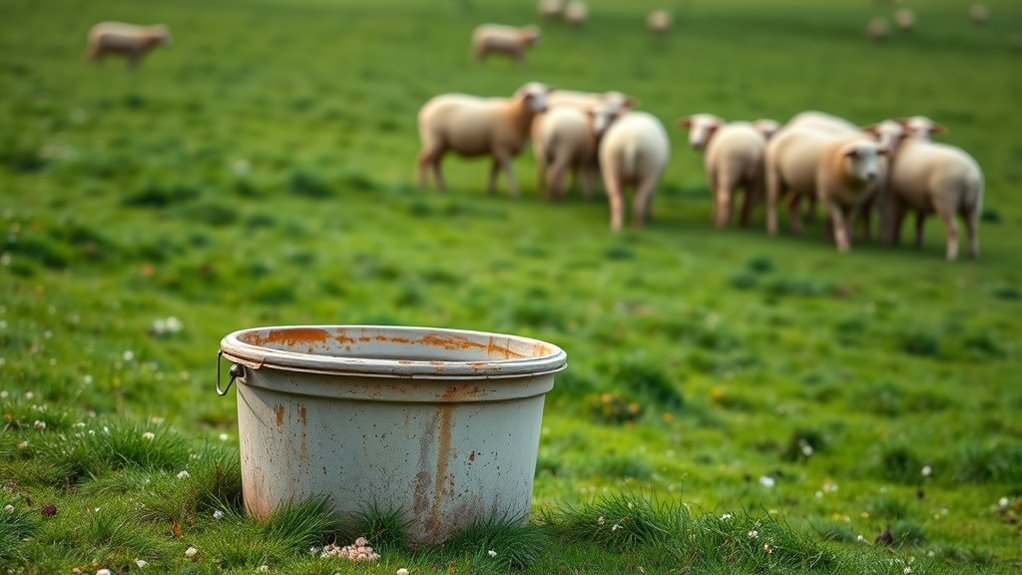
After ensuring the health of ewes and their lambs during lambing, it's vital to focus on the nutritional needs of your flock, particularly mineral supplementation.
Minerals play crucial roles in reproductive health, immune support, and growth. For instance, selenium is essential for fertility, while copper and zinc bolster immune function. Without adequate minerals, you risk diseases and decreased productivity.
However, be cautious—too much of certain minerals can lead to toxicity. Since mineral availability varies by region, tailor your supplementation strategy accordingly.
Regular monitoring through blood testing and forage analysis can help maintain proper mineral levels, ensuring your sheep thrive and remain healthy. Effective supplementation not only supports flock health but also enhances overall productivity.
Economic Considerations and Ongoing Costs

Raising sheep can be an economically rewarding venture, but it's crucial to understand the ongoing costs involved. While the initial investment is relatively low, ongoing expenses can quickly add up.
You'll face market fluctuations that impact lamb prices, making it hard to predict your income. Labor costs increase due to the daily needs of sheep, and proper fencing is essential to prevent losses from predation.
Additionally, health management, feeding, and fencing maintenance require regular financial commitment. Marketing your products also incurs costs to stay competitive.
Frequently Asked Questions
What Breeds of Sheep Are Best for Beginners?
If you're starting with sheep, consider the Dorper or Katahdin breeds.
They're easy to handle and don't require shearing, making them perfect for beginners.
The Barbados Blackbelly is also a great choice, as it's disease-resistant and thrives in various climates.
For those interested in dairy, the East Friesian offers good milk production, though it needs more care.
Each breed has unique advantages, so pick one that aligns with your goals and environment.
How Can I Reduce Sheep Care Labor Demands?
Did you know lambing accounts for over 25% of annual labor on sheep farms?
To reduce care labor demands, invest in efficient housing and feeding systems that simplify daily tasks. Utilize machinery like diet feeders and ensure easy access to pens for cleaning.
Breeding ewes with strong mothering abilities can cut down on intervention needs. Regular health monitoring and proper fencing also help prevent issues, making your sheep care more manageable.
What Are the Best Practices for Rotational Grazing?
To implement rotational grazing effectively, start by dividing your pasture into smaller paddocks using fences.
Move your livestock every 2-7 days to ensure they graze on fresh forage.
Monitor soil health and adjust paddock sizes to prevent overgrazing.
Make sure water sources are easily accessible, and be flexible with your grazing plans based on weather and animal needs.
Regularly assess pasture conditions to optimize the benefits of rotational grazing for your livestock.
How Do Sheep Handle Extreme Weather Conditions?
Sheep are like nature's weather warriors, braving the elements with resilience.
When facing extreme weather, you must ensure they've proper shelter and access to clean water. In the heat, watch for panting, and provide ample shade.
During the cold, a good windbreak and quality hay will keep them warm.
Always observe their behavior; responding quickly to signs of distress can make all the difference in their comfort and health.
What Are Effective Methods for Predator Deterrence?
To effectively deter predators, you can use a combination of methods.
Start with high-tensile electric or woven wire fences to create strong barriers. Adding guardian animals like livestock guardian dogs or llamas can enhance protection.
At night, pen your sheep near buildings to minimize risks. You might also consider noise-making devices or visual deterrents to scare off intruders.
Lastly, keep your area well-lit and clear of attractants to further reduce predator presence.
Conclusion
In conclusion, while raising sheep can be rewarding, it's not without its challenges. You've got to navigate market fluctuations, fend off predators, and manage health issues—all while committing significant time and resources. What if you overlook crucial mineral supplementation or face complications during lambing? The reality is that each decision has its consequences. So, before you dive into sheep farming, consider whether you're truly prepared for the hurdles that lie ahead. The choice is yours.

